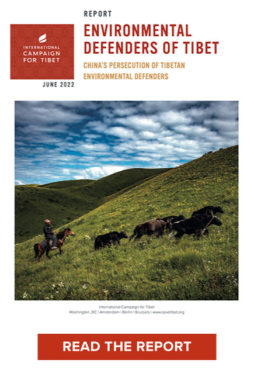EXECUTIVE SUMMARY
 Between 2012 and 2020, approximately 1,540 land and environmental defenders globally were killed. In 2019, an estimated 40% of the 304 human rights defenders killed were environmental defenders. Although many Tibetans have been persecuted and even killed for protecting their environment, their efforts and the environmental concerns they raise are less recognized by the international community, because the Chinese government and international community treat all Tibetan grievances as only related to the territorial conflict. While Tibetans continue to resist China’s illegal occupation of Tibet since 1949-50, Tibetans also work to carve out spaces within the People’s Republic of China, where they can live a life with dignity to shape the decisions that determine how their lives and the local environment are governed.
Between 2012 and 2020, approximately 1,540 land and environmental defenders globally were killed. In 2019, an estimated 40% of the 304 human rights defenders killed were environmental defenders. Although many Tibetans have been persecuted and even killed for protecting their environment, their efforts and the environmental concerns they raise are less recognized by the international community, because the Chinese government and international community treat all Tibetan grievances as only related to the territorial conflict. While Tibetans continue to resist China’s illegal occupation of Tibet since 1949-50, Tibetans also work to carve out spaces within the People’s Republic of China, where they can live a life with dignity to shape the decisions that determine how their lives and the local environment are governed.
The failure to recognize Tibet as a major focal point of environmental destruction and climate change has long term de-stabilising effects for 40 per cent of the world’s population who rely on the ecosystem services provided by the Tibetan plateau. The Tibetan plateau is on the frontlines of climate change with temperatures rising at least two times faster than the global average. As the ‘Third Pole’ and Asia’s ‘water tower’, the Tibetan plateau holds the largest volume of frozen freshwater outside the polar regions and is the source of Asia’s eight great rivers; ultimately sustaining the livelihoods of up to 1.4 billion people who live downstream. How climate change impacts the Tibetan plateau, and whether local Tibetans are empowered to mitigate and adapt to the changes is a critical question for the international community.
Given the global blind spot on Tibet’s critical environment and the Tibetan environmental defenders who work to protect it, this report attempts to recognise the Tibetan environmental defenders who have been persecuted. It col- lates and analyses information on 50 cases of known Tibetan environmental defenders who have been reportedly persecuted since 2008.
Over the last two decades, Chinese government development policies have scaled up mining, energy, infrastructure, and urbanization projects across Tibet. Of the 50 Tibetan environmental defender cases surveyed, 21 Tibetan environmental defenders are currently serving sentences in prison with an average sentence length of eight and a half years. Five have completed their prison sentences, however it is not certain that all five have been released. The whereabouts of 20 Tibetan environmental defenders remains unknown, which demonstrates the difficulties of circumventing the Chinese government’s strict information controls. Four environmental defenders have died due to abuse by state agents: one individual was fatally shot during a protest, while three died in custody.
Tibetan civil society actors, their knowledge of the unique environment and their traditional communal and subsistence-based practices are needed to protect and also build vitality and resilience in the land.
The International Campaign for Tibet recommends governments, the United Nations (UN) Human Rights Council, UNDP, UNEP, and UNFCCC:
- press China to uphold its human rights obligations and guarantee and protect the rights of the Tibetan environmental defenders, and release them unconditionally if detained;
- specifically raise the cases of the 16 Tibetan environmental defenders identified on the priority list in Appendix A, requesting their release, information about their cases, and their wellbeing;
- press China to protect the rights of Tibetan environmental defenders to seek information, freely express their opinion, associate, assemble, participate in decision-making, protect their livelihood and home, and seek redress and remedy;
- ensure free and prior informed consent; the inclusion of the Tibetan community in the decision-making and implementation process of development projects; the use of thorough and transparent environmental impact assessments projects on the Tibetan plateau;
- press China to protect and promote Tibetan language learning and practice, as it is the medium in which traditional knowledge and experience is carried and communicated;
- promote the opening up of the Tibetan plateau for scientific research and international collaboration by:
- cooperating with countries in the region to establish a regional environmental council to facilitate scientific research and transparency.
- pressing China to facilitate a country visit to China by the Special Rapporteur on human rights and the environment and/ or the Special Rapporteur on human rights and climate change.
- Develop and implement a comprehensive, stable Southeast Asia riparian environmental and security program designed to provide essential water resources to downstream populations, address increasing water pollution, adequately prepares for climate change.
- Challenge China’s ecological civilization policy and self-representation as a leader in global climate policy and action. China’s activities in Tibet re- veal its exclusionary, geo-engineering, and dangerously unsustainable approach to climate change and environmental management.

